Using basic household and kitchen tools!
Washing pegs, muffin trays, tins…
Using basic household and kitchen tools!
Washing pegs, muffin trays, tins…
Here is a fun way to give your self a brain break… grab a dice and lets roll some movement…
If you are looking for a fun Easter egg game that the kids will love, then you are in luck. Add this activity to your Easter activities and use up a few of those plastic eggs. This color scavenger hunt uses plastic Easter eggs, and it’s a very fun way to play and learn!
Use those plastic eggs to encourage gross motor skills, visual perception, and color learning in a way that kids won’t forget. While the kiddos are playing this Easter game, they are building cognitive skills AND underlying skill areas like visual scanning and other visual perceptual skills.
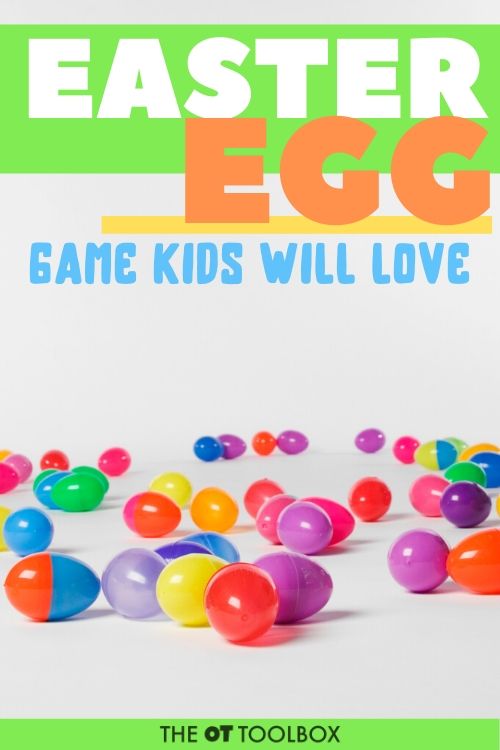
We set this Easter activity up years and years ago. (2013 to be exact!) However, it’s one of those activities that stands the test of time. If you’ve got plastic Easter eggs on hand, use them to build skills like the ones we worked on here!

This color scavenger hunt is so easy to set up…and so much fun. Kids can work on identifying color names, and color matching. I wrote different colors on slips of paper and put them into plastic eggs. The kids got to pick an egg from the bowl and “sound out” the color on the slip of paper. Ok, my 5 year old sounded out the color with help. The other two said the first letter of the word and guessed the color. They were pretty excited to “read” the color on their slip of paper!
Another idea to expand this activity is to write words and do an Easter egg version of our word scavenger hunt.

Now for the egg game…So then, they had to run off and find something that was the color of the written word on their slip of paper…and it had to FIT inside the egg. I sat and waited for them to run back and show me what they found while they tried to fit it in their egg. (completely genius way for this mom to finish a cup of coffee!)
They had a little trouble with some things, but this was a fun and different way to work on visual perceptual skills. Will that little doll fit in the egg? We weren’t sure by looking at it, but with a little fiddling, she did! Fitting the eggs together with the little objects inside was a great fine motor exercise.
They found something for each color!
Putting items into the eggs and then matching colors was a great way to work on color identification skills.
Matching colors requires visual motor skills to match colors and use that recognition in identifying the name of the color. It’s a skill that requires visual memory as well as working memory. This skill then carries over to so many other areas like letter recognition, and so much more.
Learning colors is a building block for learning in kids!
This Easter themed play activity could be modified in so many ways for learning words, colors…have fun with it 🙂
Want more ways to play and learn this time of year?
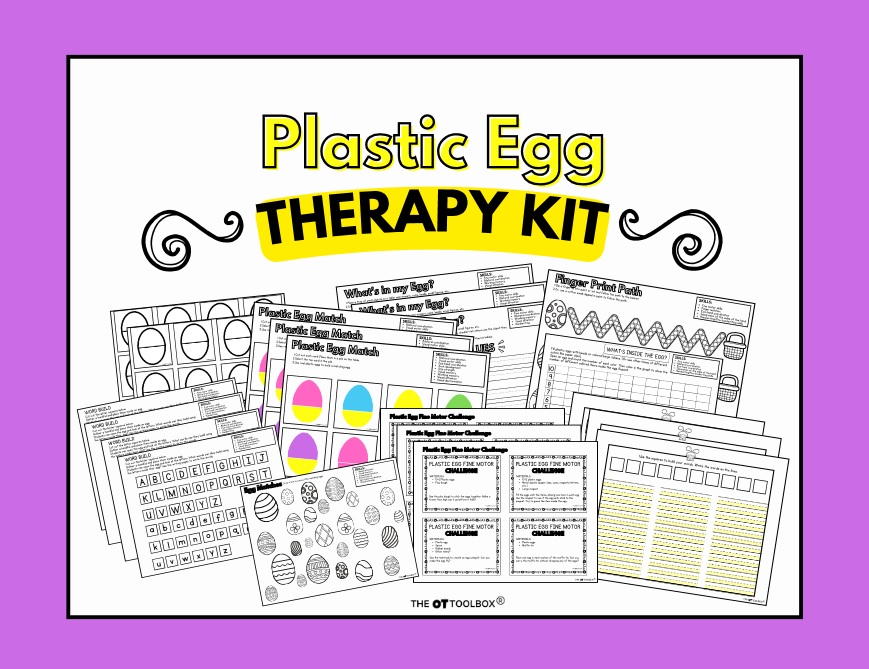
One resource we love is our $5 therapy kit…the Plastic Egg Therapy Kit! It has 27 printable pages of activities with an Easter egg theme. In the kit, you’ll find fine motor activities, handwriting prompts, letter formation pages, pencil control sheets, plastic egg activities, matching cards, graphing activities, STEM fine motor task cards, and more. There are several pages of differentiated lines to meet a variety of needs. This therapy kit has everything done for you.
Get your copy of the Easter Egg Therapy Kit here.
This time of year, one of our more popular products here on The OT Toolbox is our Spring Occupational Therapy packet. The best news is that, this packet has had a major upgrade from it’s previous collection of spring sensory activities.
Another great tool for supporting skills is the Spring OT packet…
In the Spring OT packet, you’ll now find:
All of the Spring activities include ideas to promote the various areas of sensory processing with a Spring-theme. There are ways to upgrade and downgrade the activities and each activities includes strategies to incorporate eye-hand coordination, bilateral coordination, body scheme, oculomotor control, visual perception, fine and gross motor skills, and more.
One of my favorite parts of the Spring Occupational Therapy Packet is the therapist tool section:
These two sheets are perfect for the therapist looking to incorporate carryover of skills. Use the homework page to provide specific OT recommended activities to be completed at home. This is great for those sills that parents strive to see success in but need more practice time for achieving certain skill levels.
This activity packet is 26 pages long and has everything you need to work on the skills kids are struggling with…with a Spring theme!
Here’s the link again to grab that packet.
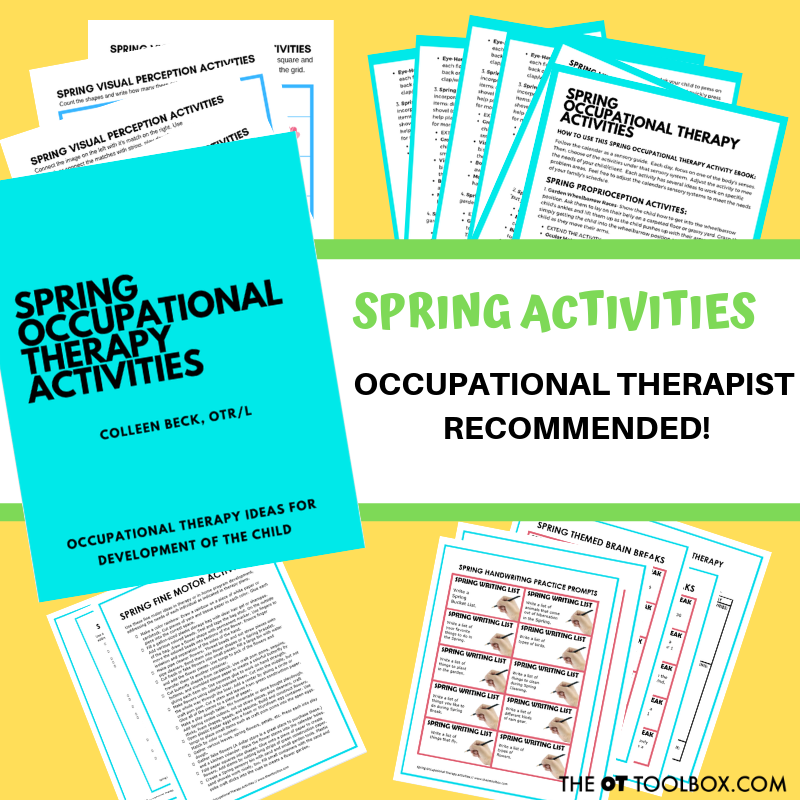

Colleen Beck, OTR/L has been an occupational therapist since 2000, working in school-based, hand therapy, outpatient peds, EI, and SNF. Colleen created The OT Toolbox to inspire therapists, teachers, and parents with easy and fun tools to help children thrive. Read her story about going from an OT making $3/hour (after paying for kids’ childcare) to a full-time OT resource creator for millions of readers. Want to collaborate? Send an email to contact@theottoolbox.com.
Pratiquer la formation des lettres à l’aide de cette police qui démontre le point de départ pour les lettres majuscules et minuscules.
Modéliser la formation de la lettre à l’avance, ensuite amusez-vous à pratiquer les lettres de l’arc-en-ciel en faisant le traçage des lettres avec plusieurs couleurs!
[Police Outline créé par Leslie auteure de KindergartenWorks]
If you are looking for creative ways to offer motor skill options to target development, then this motor skills choice board hits the mark. Use the motor skill activities to target sensory needs, physical motor development, balance, coordination or more. Kids will love the choice board options!
You might be wondering what we mean by a motor skills choice board.
A motor skills choice board is a visual tool that provides a range of motor skill activities or exercises for individuals to choose from.
Choice boards are often used in therapy sessions, in the classroom, or as a visual option to offer choices that target specific skill or task development. In the educational or therapeutic settings such as in classrooms or occupational therapy sessions, choice boards are also used to promote motor skill development and engagement.
A choice board typically consists of a series of pictures or icons that represent different activities. This can be in the format of a grid or even a BINGO game.
For a motor skills choice board, activities can incorporate many different motor tasks. These might include:
Other choice boards target tasks such as handwriting challenges or sensory diet activities. We have a popular summer bucket list choice board that encourages outdoor play over the summer months.
No matter what the format is, a choice board offers buy-in to the user, as it is meaningful and motivating to have a choice in completing tasks.
The activities may be categorized by skill level, type of movement, or other criteria, depending on the intended audience.
The purpose of a motor skills choice board is to provide individuals with a sense of choice and control over their motor skill development, while also promoting active participation and engagement. By selecting their own activities from the board, individuals can tailor their motor skill practice to their own interests and abilities, which can increase their motivation and willingness to participate.
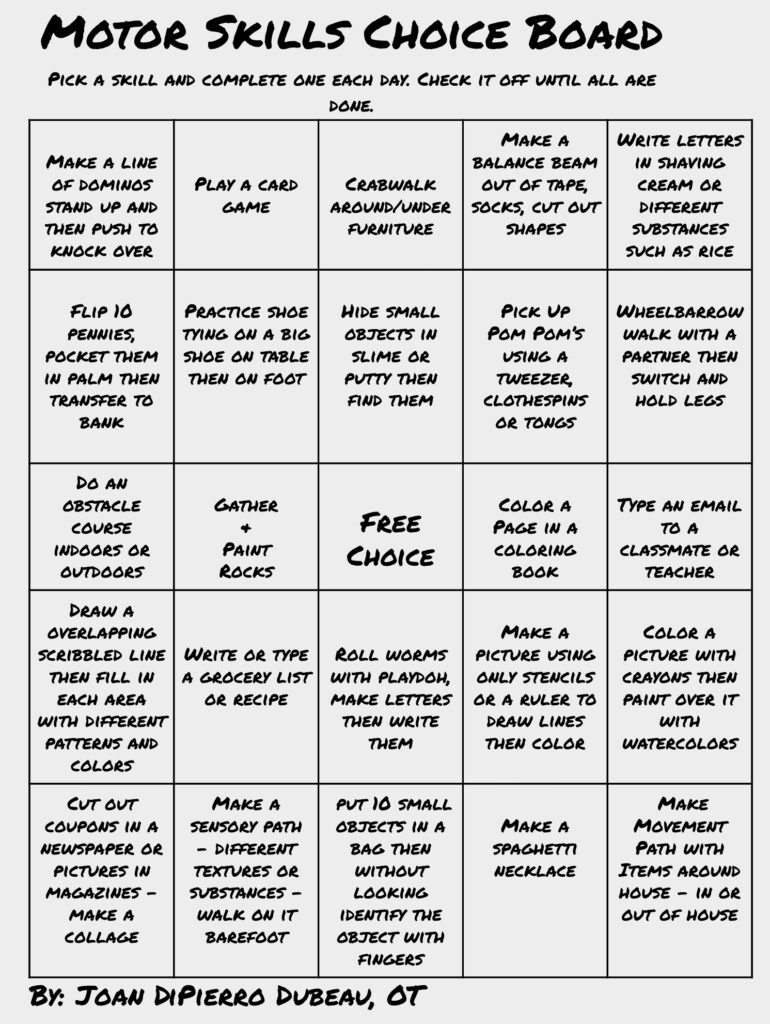
Motor Skills Choice Board
Pick a skill and complete one each day. Check it off until all are done.
|
Make a line of dominos stand up and then push to knock over |
Play a card game | Crab walk around/under furniture | Make a balance beam out of tape, socks, cut out shapes | Write letters in shaving cream or different substances such as rice |
|
Flip 10 pennies, pocket them in palm then transfer to bank |
Practice shoe tying on a big shoe on table then on foot | Hide small objects in slime or putty then find them |
Pick Up Pom Pom’s using a tweezer, clothespins or tongs |
Wheelbarrow walk with a partner then switch and hold legs |
| Do an obstacle course indoors or outdoors | Gather & Paint
Rocks |
Free Choice | Color a Page in a coloring book |
Type an email to a classmate or teacher |
| Draw a overlapping scribbled line then fill in each area with different patterns and colors | Write or type a grocery list or recipe | Roll worms with Playdoh, make letters then write them | Make a picture using only stencils or a ruler to draw lines then color | Color a picture with crayons then paint over it with watercolors |
| Cut out coupons in a newspaper or pictures in magazines – make a collage | Make a sensory path – different textures or substances – walk on it barefoot | Put 10 small objects in a bag then without looking identify the object with fingers | Make a spaghetti necklace | Make Movement Path with Items around house – in or out of house |
By: Joan DiPierro Dubeau, OT
Play using household items is one thing that parents are really seeking out these past few weeks. Therapists know the power of play. Likewise, occupational therapy activities using household items like kitchen items, spray bottles, recycled items and other everyday items are very useful in OT home programs. Here are ways to play and build skills with everyday items you’ve already got in the home.
I don’t know about you but I can not keep going to the store to buy things for my kids to do. As a mom and an Occupational Therapist, I want my kids to learn, have fun and gain skills from what they are playing with. If I take a minute, sit back and look around my house I have found that there is a variety of items I already have that can be used for play. Here are over 31 ways to play and learn at home with free materials (using things you already have at home).
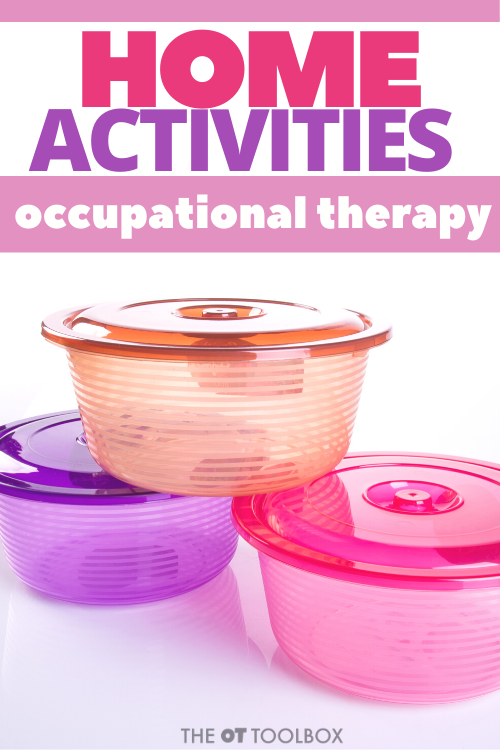
Play is such a vital component in a child development. Not only is it fun, but it allows your child to develop cogitative, physical and emotional skills. Play is how the child interacts with the world around them. It promotes language skills and interaction between others. Play builds the child’s imaginative skills. A child can learn to play with everyday objects and turn it into something else. This is seen when a child uses a car as a phone or a stick at a wand. To learn more check out this article on the, Incredible Power of Play.
There are different stages of play depending on your child’s age. Mildred Parten Newhall was a sociologist who came up with different stages of play. There are 6 stages of play in which a child will fall into based upon their age.
*Information above has been adapted from Mildred Parten’s stage of play.
It is important to know the different stages of play that your child is in. This will help to tailor activities for them. But also you can also give your child an object and just see what they do with it. The following are everyday household items that can promote imaginative play, dexterity, social skills and cognitive skills. If you would like more ideas on household items to use to help with different grasps, check out this article, WORK ON TRIPOD GRASP (AND PENCIL GRASP) WITH EVERYDAY ITEMS

Painters tape
Place tape on a high chair or table in long strips and let child pull it off
Use tape to mark of sections for a child to color or paint creating a unique picture
Place a little figurines on the bottom of the tape, attach tape to pencil and have your child rotate the pencil until the figurine is on top on the pencil
Use tape to make letters/numbers
Create a space for each child in your living room using tape to block off sections
Take small pieces of tape and place them throughout the house and have a scavenger hunt
Practice wrapping boxes using wrapping paper and tape
Plastic containers
Have your child match up the different sized lids to the containers
Use the containers to make a sensory bin- fill with rice, beans, kinetic sand, cotton balls, water beads, or any item you want. Hide toys in the materials, have tongs and measuring cups to pour and scoop.
Place different colors of construction paper on the bottoms of the containers and have your child go around the house and place matching household items based on their color into the correct colored container.
Place paper on bottom inside the container, tape it down, squirt paint onto the paper and roll a marble back and forth making a neat design.
Cut slits into the lid of the containers. You can then have your child place popsicle sticks, coins, pipe cleaners, into the slits.
Large Legos
Place the legos upside down. Have your child use tongs to place colored pom poms into the holes on the bottom of the legos. They can even work on color matching this way.
Take a picture, cut it into pieces and tape the pictures to the legos. Then your child can form the picture again by putting the legos together, like a puzzle.
Place different letters on the legos and have your child work on building their names
Work on replicating patters. You make a tower then have them make a tower. You make a bridge and then have them make a bridge. See if they can replicate when you have created.
Place legos in paint and let them use it as a stamp
Push legos into playdough to make a design ( ex. A road for their car).
Spray bottle
Have your chld spray the plants inside and outside your house to water them.
Color a coffee filter with markers, have your child spray it and watch the colors run off
Use a spray bottle in the bathtub. Bring in toys, lather them with soap and have your child spray them off
Draw on the sidewalk with chalk and have your child “clean the sidewalk” by spraying water
Place a few drops of food coloring into spray bottle, add water, shake and have your child spray a piece of white paper to make a colorful picture.
There are so many ways to play in the kitchen that help children develop fine motor skills, explore the senses, improve eye-hand coordination, and develop motor planning skills.
Try these 4 ways to play with kitchen items AND develop fine motor skills:
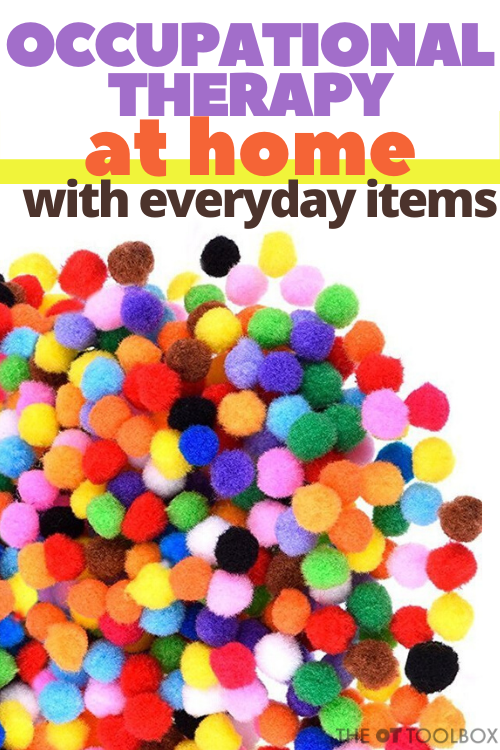
Hope you find these ideas helpful and easy to do. As you have read there are many different ways to play with everyday item. Have fun and see what creative things your child comes up with.

About Christina: Christina Komaniecki is a school based Occupational Therapist. I graduated from Governors State University with a master’s in occupational therapy. I have been working in the pediatric setting for almost 6 years and have worked in early intervention, outpatient pediatrics, inpatient pediatrics, day rehab, private clinic and schools. My passion is working with children and I love to see them learn new things and grow. I love my two little girls, family, yoga and going on long walks.
Hi Guys!
Here are some good fine motor control exercises to work on at home!
See you next week!
This letter formation activity for teletherapy sessions is one that is perfect for virtual sessions. Use the slidedeck to upload right to your Google classroom or other teletherapy platform. You can go through the slides along with the child, or use them as an independent occupational therapy home program without individualized intervention from the occupational therapist. There are many underlying skills that play a part in letter formation. When using them in OT interventions, therapists can intervene with specific adaptations, modifications, and strategies to help kids improve on various skill areas such as visual motor skills, fine motor skills, motor planning, bilateral coordination, crossing midline, sensory processing, core strength, balance, positioning, and more.
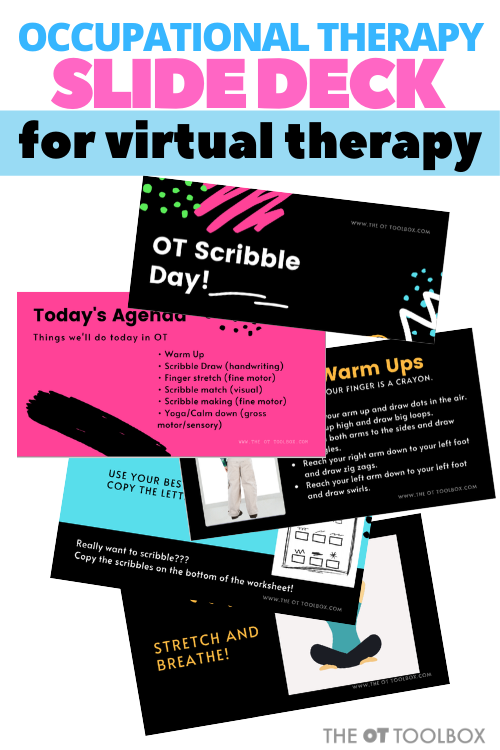
This free virtual therapy session outline goes through several areas:
Warm-Ups
Handwriting
Fine Motor Skills/Motor Planning/Direction Following
Visual Motor work/Fine Motor Skills
Yoga/Calm Down/Gross Motor/Balance

This free virtual therapy activity set can be used in face-to-face interventions, too. The options are pretty much limitless.
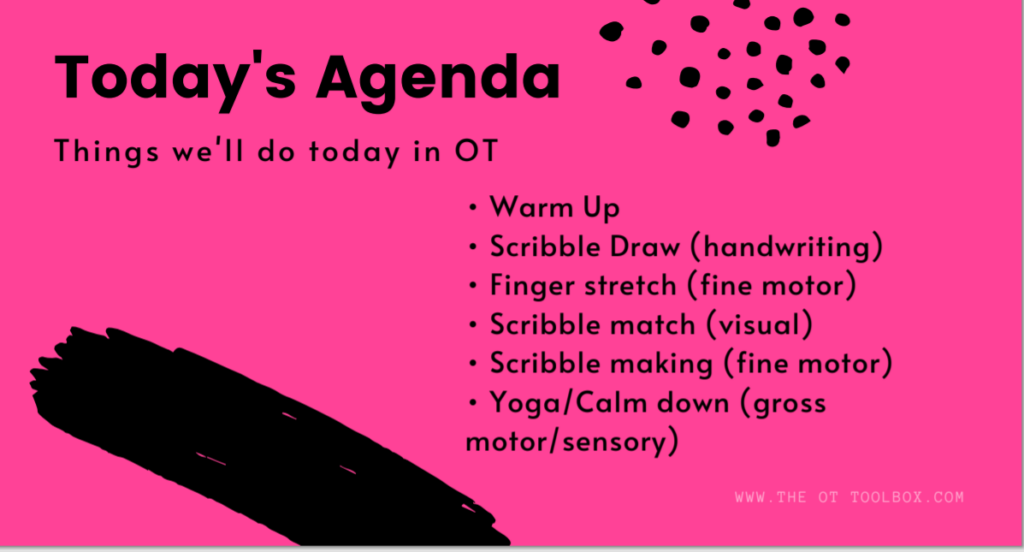
Along with the worksheet is one that I created as a free printable that went out to The OT Toolbox newsletter list.
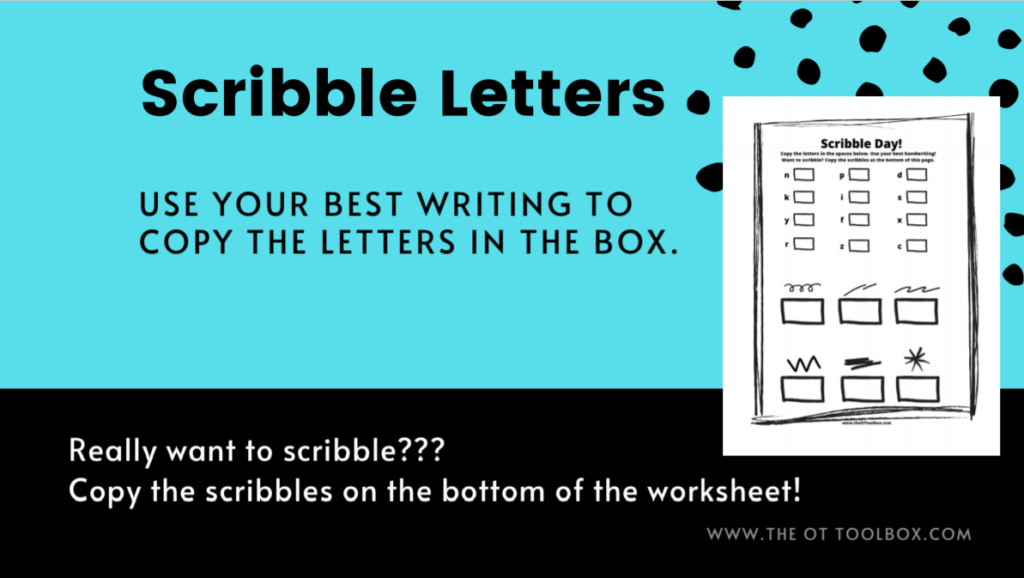
In the printable worksheet, children can work on letter formation and writing letters in a small space. Kids can copy the letters and then copy the scribbles into the boxes at the bottom. This printable page is free for you today, too! Bonus news is that when you access this freebies, you’ll be entered onto The OT Toolbox subscriber list. Win, win, win, right? Don’t worry, you can unsubscribe at any time, if you like.
If you would like free printable tools like this one, subscribe to our newsletter. You’ll get resources and tips in your inbox, along with the weekly Friday Freebie. It’s a fun time!
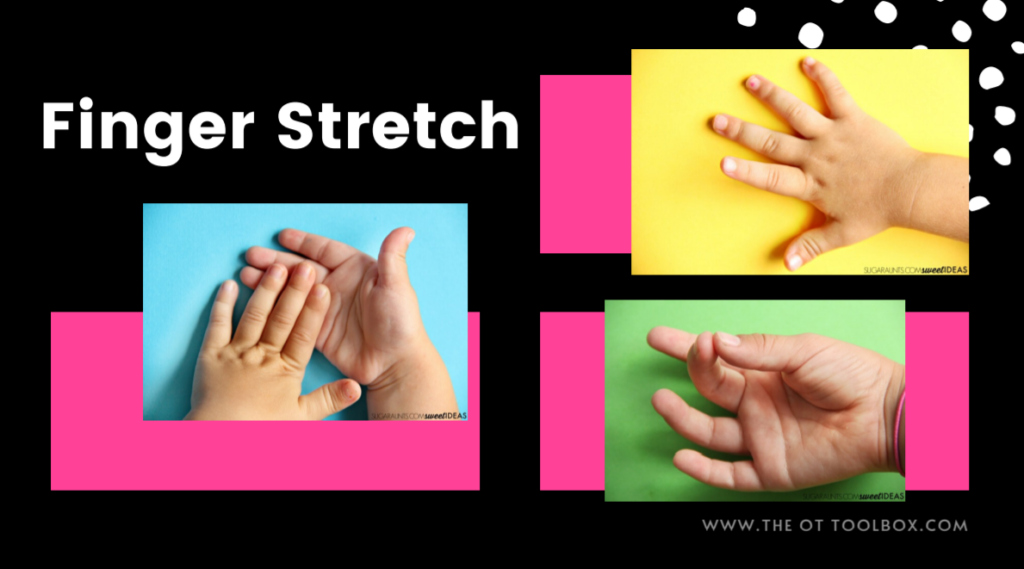
Enter your email to access this free “Scribble Theme” Occupational therapy slide deck:
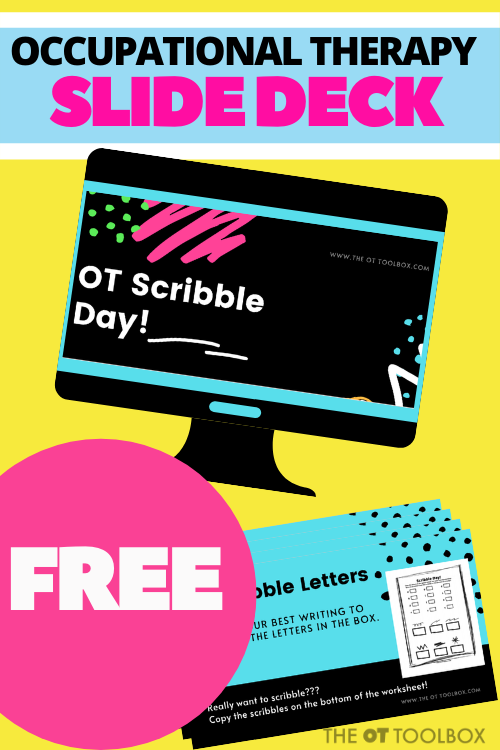
With therapy sessions now moved to online settings, and children receiving virtual therapy as their source for occupational therapy intervention, you may be wondering HOW to help your child thrive in virtual therapy sessions. With many parents experiencing their first encounter with online therapy, I wanted to put together tips that you can pass on to parents to allow their child to succeed in online therapy sessions. Here are common teletherapy activities that can serve as a starting point. Remember that occupational teletherapy is a virtual version of face-to-face occupational therapy sessions.
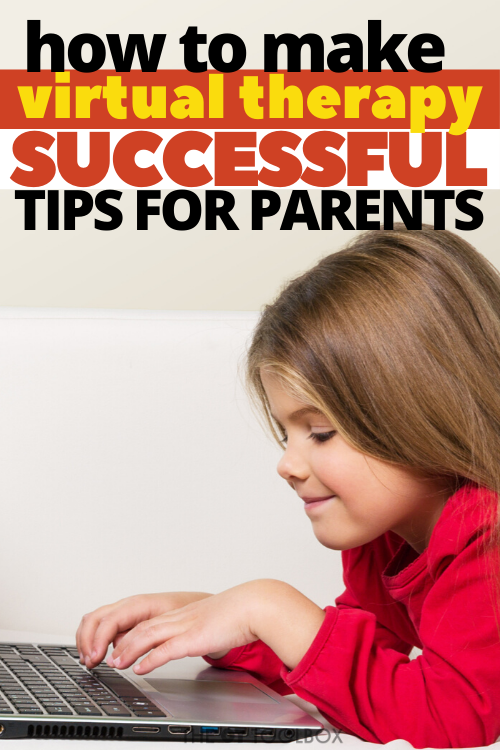
Let your therapist know what you need and where your child is struggling- The family and parents are part of the “team” with the child being the center of that relationship. Parents are often times the voice for the child to communicate needs or frustrations of the child. With new realities as a result of public health issues, kids can struggle in unprecedented ways. Be sure to communicate any new changes with your child’s therapist.
Gather any needed materials- Consult with the therapist prior to the virtual session by email or text to find out what materials you should have ready for the session.
Prepare your child for teletherapy sessions- Add a computer “appointment” to your child’s written or visual schedule. Let them know in advance (at the appropriate level of understanding of your child).
Prepare the area- Set up a specific location for teletherapy sessions to occur. Have headphones or a headset there and ready for your teletherapy session.
Log on and check internet connection a few minutes before your scheduled time- Realize that your child’s therapist likely has between 6-14 virtual therapy sessions scheduled each day. They are striving to meet the needs of your kiddo right along with all of the other kiddos on their caseload. Being on time provides the best service for your child and is considerate of the therapist’s hefty schedule.
Try a trial run- Consider setting up a trial run with use of the headphones and a video conference call with a grandparent or friend to practice speaking into the headphones or computer microphone. Try the headphone volume at this time, too. This is a good time to test the lighting in the room, and placement of the computer’s camera.
Prepare the household- Let siblings or others in the home know that the teletherapy appointment is scheduled. This is a time for the child to interact with their therapist. Try to reduce background distractions if possible. Put pets and distracting toys away during the teletherapy session.
Consult with the therapist regarding being an “e-helper”- Some activities and interventions may require the use of an adult to act as an e-helper. This is especially true for younger children or during hands-on tasks. Here is more information on understanding teletherapy and e-helpers.
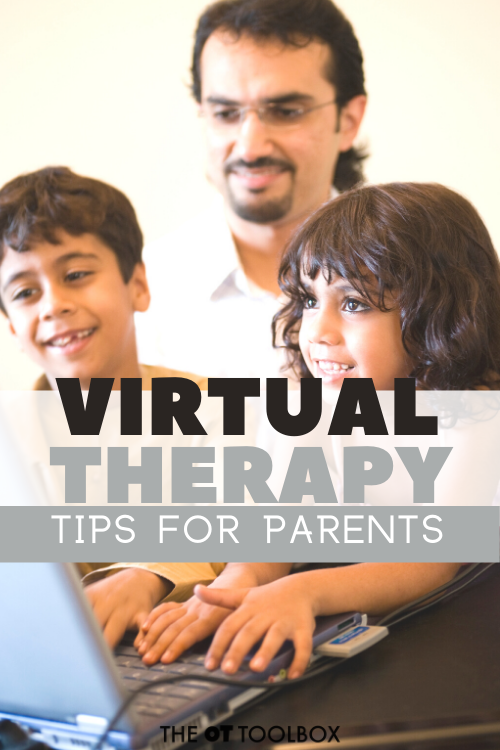
What would you add to this list? Do you have any suggestions for parents who have children receiving occupational therapy teletherapy for the first time?